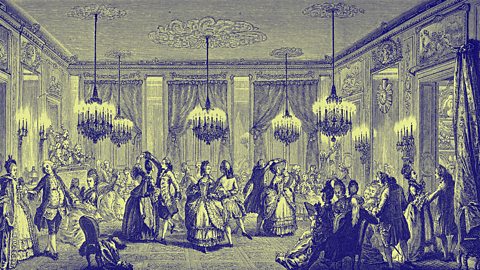Musical description
The third and final movement of Bach's Brandenburg Concerto No.5 is a fast and lively dance. The tempo is marked as allegroLively and fast., or quick. It was common for composers to use the same features throughout their work to keep in fashion with the dances. Five of the six Brandenburg Concertos were written with the same order of tempoThe speed or pace of performance in speech, dance or music..

The overall structure of the third movement consists of three main sections, known as ternary formA musical form in which the opening section returns after a central contrasting section. :
- A - bars 1 to 78 - fugueA musical form in which parts enter one after the other with the main theme or subject. These build to create a complex contrapuntal texture. exposition
- B - bars 79 to 232
- A - bars 233 to 310
Concerto grosso
Brandenburg Concerto No.5 in D Major, third movement, is a concerto grossoA Baroque piece for a group of soloists and orchestra.. This means that the work uses a group of solo instruments - the concertino - rather than a single soloist. Overall there are three main groups of instruments - the concertinoGroup of soloists in a concerto grosso., the ripienoA group of instruments that consists of non-soloists. The opposite of the concertino. and the continuoThe bass part in Baroque music - typically played by a cello, and used by chordal instruments such as the harpsichord. .
In this work the soloists are flauto (flute) and violino (violin) and sometimes the cembalo (harpsichord). The ripieno is a string ensemble, violino (violin), viola, violoncello (cello) and contrabasso (double bass). The continuo part is played on the cembalo (harpsichord).
Form and structure
The third movement has a simple 2/4 time signature. However, J.S. Bach creates a gigueA lively dance, typically in the Baroque period. feel by writing continuous triplet quavers. In bar 110 the harpsichord plays triplet quavers, which are three quavers played in the space of two quavers. The triplet quavers are groups of three notes, creating a sense of 123, 456 rhythm against the written 2/4 time signature.
The third movement employs a fugueA musical form in which parts enter one after the other with the main theme or subject. These build to create a complex contrapuntal texture. structure and texture. In a fugue a melody starts the piece (the subject), which is then repeated at different pitchThe frequency of a sound. Sounds with a high pitch have a high frequency. and imitated by different instruments throughout the work. This creates a complex texture of independent moving parts known as counterpoint'Tune against tune' - two or more independent musical subjects that contrast with each other..The opening is presented like this.
- The violin plays the subjectThe main tune of a fugue or piece of music in sonata form. in bars 1 and 2, and then the countersubjectThe continuation of a musical line, which often accompanies or responds to the subject..
- The flute begins in bar 3, playing the subject five notes higher, and then the countersubject.
- The harpsichord plays the subject in bar 9.
Dynamics
Composers in the Baroque period generally did not write dynamicsRefers to the softness or loudness of a piece of music. into the score, leaving the louds and softs to the performer. The term terraced dynamics means that there are no crescendos or diminuendos, just loud or quiet playing.